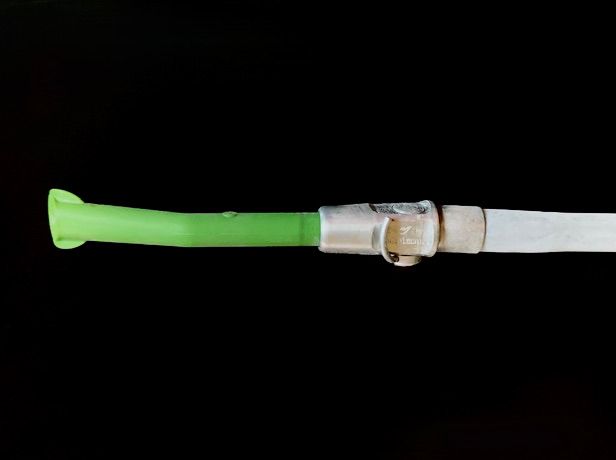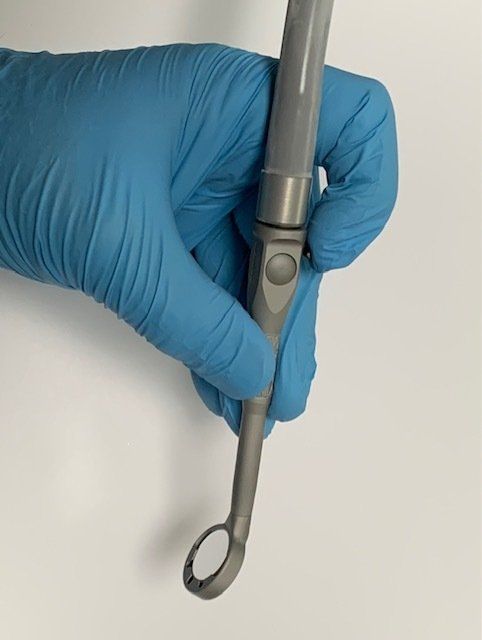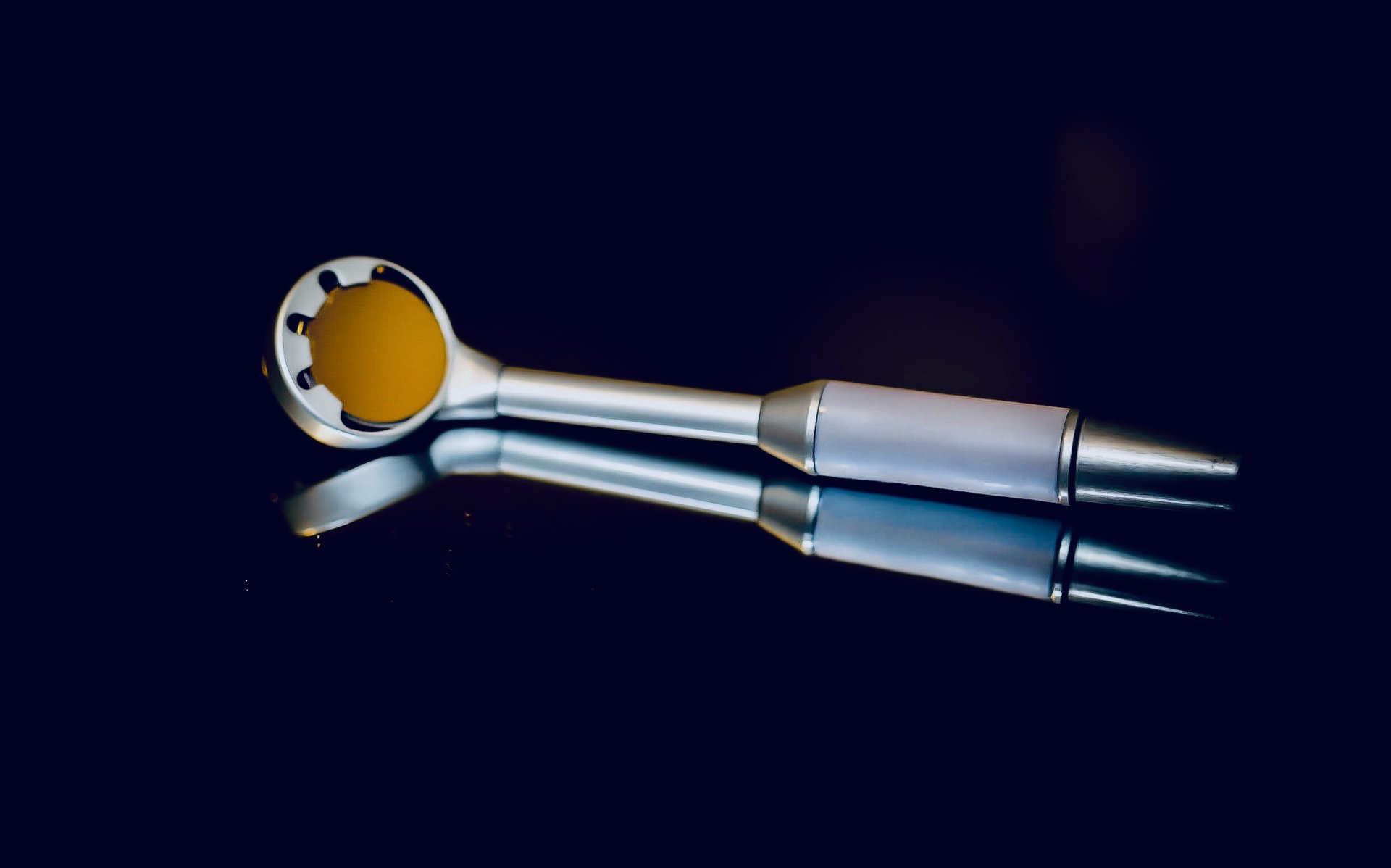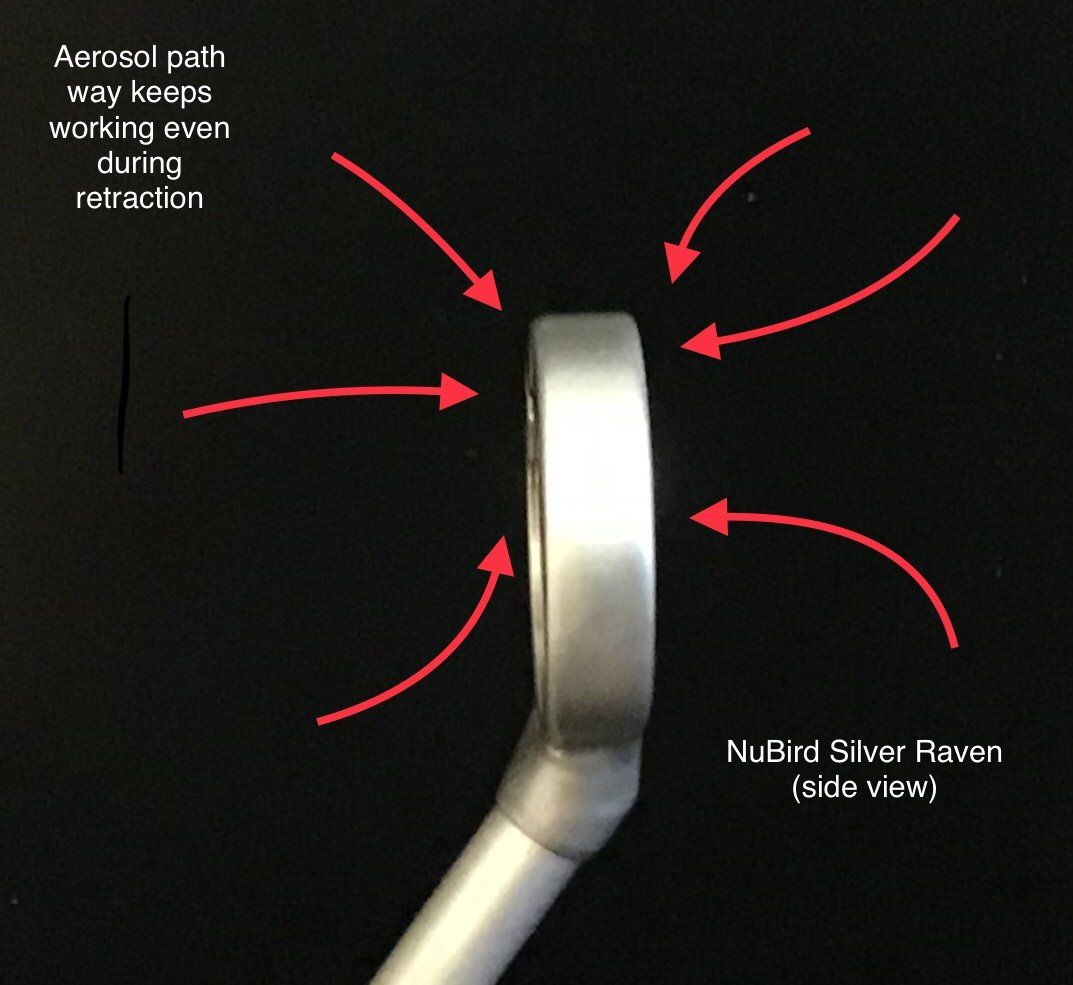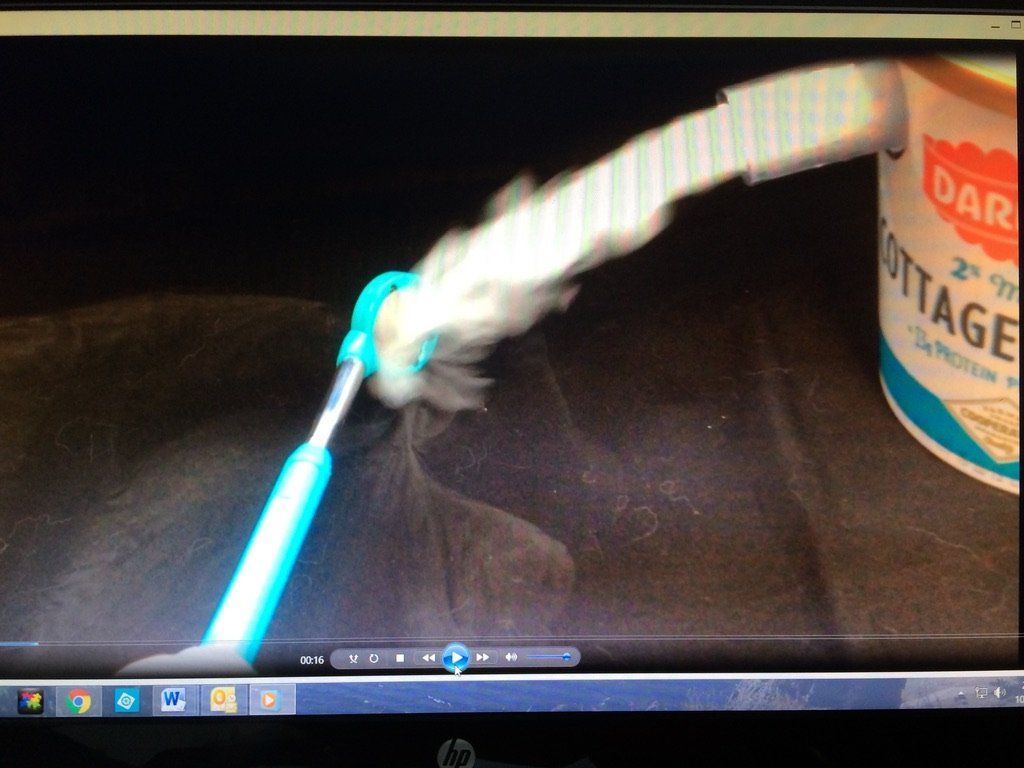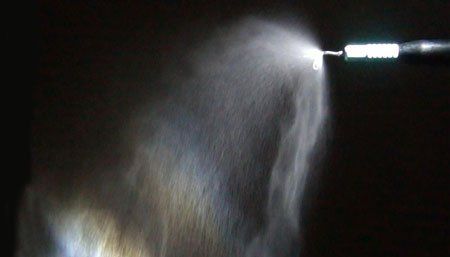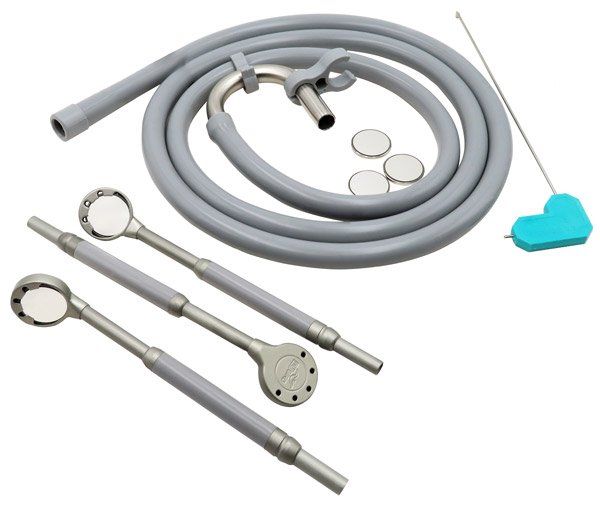In recent years, the dental industry has experienced many changes. The evolution of dentistry has
caused a quiet revolution with those who tend to resist change. New State health regulations and CDC
compliance has been adopted in many states and provinces in the USA and Canada. Clinicians who have
worked in dentistry for years are being challenged to “bite the bullet” to leave outdated traditional methods
of practice and use advanced technology devices. Many clinics are now feeling pressure to evolve just to
keep up and comply with the new standards of care. New HVE hybrid devices are available to help dental
professionals perform procedures, enjoy better health and safety with improved ergonomics.
In order to manage pooling water in the oral cavity during dental procedures, patients use to swish
with water and spit in a round shaped bowl called a Cuspidor. As years passed, air evacuation systems
came along. The dentist used a long strait evacuator tube to suction out the water in the mouth during
procedures.
Dental hygienists came into the profession who were trained to clean patients teeth using hand scaling instrumentation. The process of cleaning teeth by hand was very labor intensive. Magneto restrictive devices came out in the 1950s which helped speed scaling procedures to help remove deposits. These new scaling devices were used mainly for patients with heavy deposits. Many hygiene operatories then, were not plumbed for HVE or highspeed handpieces. Hygienists were
forced to use whatever they were given which was usually just a slow speed prophy angle and a LVE (low-volume evacuator). Use of a saliva ejector was easy to adapt and usually hung inside the patient’s mouth. This would allow evacuation to be hands-free while the hygienist used a mouth mirror and scaler.
Often, the hygienist required help from a dental assistant to use HVE to suction the water during the ultrasonic scaling procedure. When no assistant was available or if the operatory was not plumbed for HVE, the hygienist had to resort to using a saliva ejector to manage all the excess water.
Technology advanced quickly with improvements. Advanced magnetorestrictive) devices came on the market along with air polishers and lasers. These devices were found beneficial and time saving for providers to use. Some clinicians who used HVE by themselves developed repetitive strain issues which became a barrier to use of HVE equipment.The complaint was the hose felt heavy and stiff to angle in the mouth. Due to the ease-of-use and convenience, hygienists gravitated to just using saliva ejectors as the only suction apparatus. (9)
New health concerns are awakening clinicians to a higher awareness of aerosols and the need for protecting providers as well as patients. While illnesses are commonly shared in the workplace, the risk of exposure increases significantly for hygienists using powered instrumentation such as ultrasonic and air polishing devices. Bacteria and viruses can rapidly spread through spatter and aerosols produced by these types of treatments and while it can’t be proven that a viral infection can spread via contaminated aerosols resulting from powered instrumentation it’s certainly offers a possible explanation for office wide epidemic’s that commonly occur. (6)
Powered instrumentation is in widespread use in North America, yet safety standards and regulations concerning the use has not sufficiently evolved. Currently 36 out of the 50 states in the USA claim they have adopted CDC infection control guidelines for dental infection control standards. 15 of these states have adopted the guidelines within the last two years starting what appears to be a new trend. In the CDC guidelines under (PPE)personal protective equipment it clearly states: “Aerosols can remain airborne for long extended periods of time and may be inhaled. Aerosols should not be confused with the large particles that makes up the bulk of the spray from hand-pieces and ultrasonic scaler‘s. The spray might contain certain aerosols (ie. particles of respirable size<10um). Appropriate work practices including use of dental dams (172) and high velocity air evacuation should minimize dissemination of droplets, spatter and aerosols.(1)"
In the CDC guidelines section under the Blood-borne pathogen‘s and aerosols section it also states: “To prevent contact with splashes and spatter dental healthcare personnel should position patients properly and make appropriate use of barriers (eg.,Face shields surgical masks gowns,rubber dams and high-volume evacuators.” (2)
Some clinicians are unaware and or ignorant where aerosol management is concerned. Few agencies
enforce compliance. Infection control guidelines and regulations are currently under review in the few
remaining states. We anticipate these reviews will result in new updated rule changes to include a mandate for the use of HVE. While HVE is the top recommended solution for controlling aerosols and reducing risk of contamination
by the ADA (2) and CDC,(1) some clinicians still secretly use saliva ejectors. Isolation devices are also a common choice even though some have been scientifically proven to offer no safety protection from contaminated aerosols.
So what exactly is high volume/velocity evacuation(HVE)?
Definitions of Terms Used:
HVE: High Volume Evacuator: Device which can remove a large volume of cubic feet air.
CFM:
Air volume measured in Cubic feet of air per minute.
InHg: Static pressure meassurement in inches of mercury.
Velocity:A speed function of cubic feet per minute and inches of mercury. Velocity equals the speed of which air travels through a device.
High Velocity Evacuation: A function of a given amount of cubic feet per minute(CFM) and a measured
amount of inches of mercury (inmg), usually with an increase in air speed near a port or opening.
Terminus end point: The very tip or end of the device being used.
LVE: Low volume evacuator is a device with low cubic feet per minute.
In the article “Aerosols and Splatter in Dentistry” by Stephen K. Harrel and John Molinari, it states “For a suction system To be classified as an HVE, it must remove a large volume of air within a short period.” (7) Air volume is measured in cubic feet per minute (CFM). While both HVE and LVE maintain the same static vacuum pressure (InHg) using the same vacuum system, the difference in air volume is due to device design at the evacuator tip (terminus end point). LVE devices like saliva ejectors cannot remove enough air volume to be classified as HVE. *An HVE can remove airborne contamination as long as it has large volume or wide air pathway.
So why do we need to be using HVE?
As discussed earlier, research shows that aerosols and splatter produced during dental procedures do contain saliva, blood, bacteria and pathogen’s. This risks the spread of illnesses such as common cold, Flu, influenza, herpes,SARS, Hep C, Candida Aures,TB. (8)This is especially a concern for dental providers who work on patients with undiagnosed or undetected cases. Many clinicians have been duped into believing it is OK to only use a saliva ejector to manage the aerosolized water spray. From an infection control standpoint, providers don’t realize what is going on when generating aerosols. HVE offers the best solution for controlling aerosolized particles before they leave the mouth and studies have shown HVE to reduce over 90% of aerosols. (7)
Dental clinics have air compressors and a separate vacuum system. The compressor runs by an electric motor which has pistons that pressurize air for the air water syringe and air motors such as high and low speed hand-pieces. The vacuum unit has its own electric motor which drives an impeller in order to create a vacuum. If a vacuum pump does not have enough inches of mercury (inhg) regardless of CFM capacity, it can lower performance. Also when there are more users on the suction system, it tends to lower CFM and InHg. To have a technician set the pressure limit switch to 10 to 12 InHg is a starting point but certainly not the only factor to investigate when troubleshooting poor clinical performance. For instance, if there is a leak in the vacuum line near the user end, vacuum power will be diverted away.
In the article Aerosols and Splatter In Dentistry by Harrell and Molinary it states, “The usual HVE used in dentistry has a large opening (usually 8mm or greater) and is attached to an evacuation system that will remove a large volume of air (up to 100 cubic ft per minute).”(7)
Back then, a straight HVE tip plugged into the valve/tubing may have been the only apparatus used at the terminus end point. When they mentioned “evacuation system… 100 cubic feet…” and “8mm or greater,”
their reference is to the vacuum motor/pump and tubing/valve respectively. 100 cubic feet per minute? Are you serious? That is like sucking the air out of over 100 paper grocery bags (approx 3/4 cuft) of air per minute through that tiny HVE tip! A better example is if It took 10 seconds to evacuate 1 cu ft of air, 10 x 6 = 60 sec.= 1 minute = 6 cuft per minute. I checked a healthy new evacuation system in the dental office where I work and it performed at a range of 9-10 cubic ft per minute with a static reading of 12 InHg at the valve opening terminus end! 100 CFM per minute may be the evacuation motor’s capacity but when airflow travels through long lines and reaches the terminus end of a device, it can be quite a different story especially if the system has clogged lines. In order to determine what the mean level for adequate HVE requires more research. For now, we as providers should be using systems and devices which maximize air flow performance.
So what would one do to accurately measure cubic feet per minute (CFM)?
Cubic feet per minute of airflow is a difficult task to measure and this type of testing requires very
specialized equipment. Dental office repair technicians usually only check for inches of mercury (inhg).
This is only half the equation. To be more acurate, they would need to go into each clinical operatory and
actually check cubic feet per minute (CFM) at each station. Measuring cubic feet per minute at each
station is a necessity in order to determine the health of the system.
*Combinations of both static (InHg) and cubic feet per minute (CFM) is necessary to have a
healthy vacuum system.
A simple timed water test can reveal a range of suction volume in devices at their terminus end point. Use a stop watch and 1 cup of water and measure the speed of how long it takes to suck up that water using a straight HVE tip, then use the same procedure with a saliva ejector to set the high and low benchmarks. One can then test other suction devices in
order to measure their performance.
Another scientific way to test air path width at the terminus end point is to spread 1/4 cup salt or talc on a table and drag and evacuation device through it in order to view the width of the air pathway through the device.
Analysis with this test can reveal a device with design flaws.
Today, technology has produced hybrid HVE devices with multiple hole patterns at the terminus end point. They offer a wider air path foot print which captures more aerosolized water and spatter.
A television infomercial for the popular “Shark”vacuum cleaner compared it’s features against a competitor. Their demonstration was similar to what is needed for dental evacuation devices. Performance was tested to show how well the vacuum picked up particles on the carpet and floor and its wide air path which makes vacuuming a room
faster. Mobility of the vacuum offered easy turning and access to difficult to reach places like under tables. The vacuum unit was lifted up showing how light in weight and Ergonomic it was to use.
The added brush head attachment contacts the floor with a broader surface area than the hose end enabling it to inhale a wider air path of particles.
Common sense tells one to look at their home vacuum. The large diameter hose is a picture of
high volume. If one were to just use the hose to clean, it would take a long time to suck up all the dirt and dust particles. This is due to how narrow the air pathway is channelled at the terminus end point of the tube. Yet if one puts on a wider floor attachment, cleaning can be completed much faster because of a wider surface area foot print or air path way which pull in a broader path of particles!
Aerosols are similar to small dust particles on the floor. Use of a single directional evacuator (like the straight hose) only offers a certain width of air pathway. Using a device with wider surface area /air path foot print at the terminus end point, can broaden the amount of aerosols pulled in. Just having high inches of mercury (InHg) and high cubic feet per minute (CFM) does not mean great aerosol protection. A wider air path foot print at the terminus end point is also necessary.
**High volume, high port velocity and wide air pathway in dental evacuation is needed for proper
management of water and aerosols.
Choosing the right device:
It is very surprising to find products on the market labeled as HVE but perform lower than the level of a
saliva ejector. Remember when suctioning up water, it is a medium approximately 1000 times more dense
than air. Most of the time in dentistry we are working with a mixture of mostly air with water and when
combined, produces spatter and aerosols.
Is there a solution? How do we address these problems and encourage more clinicians to use HVE as
a safety standard? One way is dental clinicians need to be educated and learn more about a device’s
design features in order to know what to look for.
Device design is extremely important.
A straight HVE tip has high volume and a given width of air
pathway foot print. Another device may perform with slightly less air volume (CFM) but have higher port
velocity and wider air path foot print enabling it to capture a broader pathway of aerosols. Some examples of hand held HVE devices are: Ergo Vac, Purevac, multi-axis spiral suction, Nu-bird HVE mirror/Hose, Angle Ease, HVE short tip. Many are ergonomic, lightweight and easily used in the mouth.
Hands-free stationary evacuation devices and adapters utilize the HVE port. These were designed to collect water in the back of the mouth. Smaller tubing and hole size limitations in some designs could restrict airflow and lower performance of air volume (CFM) and air velocity. Examples of hands-free stationary devices are:
The Leaf, Blu-boa, and Iso-systems. These devices were designed to work for pooling water but according some studies,(4) tend to be ineffective for aerosol management.
Evacuation is the secondary function to most dental procedures being performed, clinicians are more likely to choose a device which offers the greatest convenience and comfort so they can focus on their primary task. While HVE is the best option, like the “Shark” vacuum cleaner demo, three of the same factors which directly impact its use are Performance, Mobility and Ergonomics.
Performance:
Clinicians need to know whether the power/static pressure (InHg), airflow volume
(CFM) and port velocity of their HVE performs to adequate safety levels. Clinicians must rely on existing
data from independent and manufacture tests to determine the effectiveness of the devices they use and
*just because an evacuator plugs into an HVE suction port does not mean it is operating at an
acceptable suction volume level on the terminus or user end point. Vacuum performance can vary
greatly from office to office. Clinicians need to look for devices which have high port velocity and wide air
path foot print for good aerosol reduction.
Mobility:
In order to work safer and efficiently, HVE devices need to be light in weight and hand held
approximately 6 mm to 15 mm away from the active aerosol generating tip. For example the device
cannot be placed in the posterior of the mouth like stationary hands-free devices when the clinician works
in the anterior area of the mouth. Mobility is key and there are at least a dozen locations within the mouth
that clinicians need to access with HVE. Clinicians need to look for designs that offer full range of mobility,
hand held and easy to manuver in all areas of the mouth.
Broads air path evacuation with multiple ports
help enables the device to keep from sucking up tissue and blocking all of the ports. The long straight
tube shape of a standard HVE tip can be awkward to correctly handle. Clinicians have to pay careful
attention to tip angulation to avoid getting the suction locked onto their patients cheek or tongue.
Ultimately one needs to be able to move their suction device within the patient’s mouth without risking
discomfort while keeping focus on the treatment they are performing.
Ergonomics:
This important factor can make the clinicians job more time consuming
difficult to perform and cause long-term injury. An average HVE hose weighs
approximately one pound and feels very stiff to manage. Hygienists complain of too much
pull on the wrist and arm which can lead to repetitive strain injury. Because the usual
standard HVE units are hand held, clinicians are unable to use their mouth mirror for
indirect vision so they have to rely on direct vision only which can cause excess strain on
the neck and shoulders. New lighter weight designs have features that eliminate hose
twist and drag which can reduce the risk of repetitive strain injury. The HVE device needs
to have multi functional capability eliminating the need to switch devices mid procedure
(ie.. laying down the suction to pick up the mouth mirror to view.)
Back to the Shark vacuum example where the design features allow cleaning tasks to be easier. New hybrid
technology for HVE devices now come with more complex features that offer innovative solutions to the
performance, mobiliity and ergonomic challenges of the standard straight HVE tip model. One new HVE
system on the market is the Purevac by Dentsply International. It performs with a wide air pathway. The
opening offers aerosol reduction during ultrasonic scaling procedures. The hose is ergonomic with free
rotation and light weight making it easy to use. The angle of the mirror handle can be beneficial for
indirect view of anterior teeth as well as chairside assisting.
Another example of a new complex design hybrid is the Nu-Bird HVE Mirror System. The mirror head looks like a lollipop that has 10 multi-directional ports positioned around the periphery. These ports are very specific in size allowing the air pathway foot print to be approximately one inch in diameter. The patented design pulls air from both sides, front and back, verses a single-directional device like a standard HVE tip. As air flows through each of the ports, acceleration occurs while simultaneously pressure drops. That drop in pressure is the additional
vacuum which helps quickly grab and capture aerosols and water in the mouth.
This is another example of “Bernoulli’s principle” at work and how high port velocity supplies a
“Venturi effect” that provides additional vacuum. The reason planes fly is the air rushing over the top of the wing creates a low pressure causing the wing to lift.
Inverse relationship:
Complex design, Increased ease of use.
Simple design, Decreased ease of use.
There are several reasons clinicians would benefit from using the newer technology of an HVE/mirror
system combo.
1) Higher accuracy with clear indirect vision.
2) Easier access and mobility in all areas of the mouth.
3) Ergonomic design features that reduce strain on hand and arm
4) Better water management and capture of generated aerosols
In the past, main stream dental clinicians have not had access to evacuation devices which ergonomically utilized HVE but now can. Dental professionals should apply themselves to evolve in learning to use some of these newer technology systems so they can benefit from the better performance, health and safety and improved ergonomics and thus prolong their careers.
Written by Laura Emmons RDH
Laura Emmons, a graduate of Lake Washington Institute of Technology, works full time as a clinical hygienist. She and her husband own and operate a design and manufacturing company called Nu-Bird which
pioneered new technology of a mirror system which is combined with HVE for dental clinicians. You can reach Laura at info@nu-bird.com or visit nu-bird.com and face book. 5/24/2019
References:
1) Centers for Disease Control and Prevention. Guideline for infection Control in Dental Health-Care settings-2003
2) Aerosol and splatter Contamination from the Operative Site During Ultrasonic Scaling Sept 1998, volume 129, Issue 9 JADA,Pages 1241-1249
3). Aerosol and splatter. (J Am Dent Assoc. 1998) PMID: 9766105 (Pubmed-Indexed for MEDLINE) CDC guidelines: Bloodborne Pathogens anbd Aerosols
4) Holloman, J. L., Mauriello, S.M.,& Arnold,R.R. (2015) Comparison of suction device with saliva ejector for aerosol and spatter reduction during ultrasonic scaling. JADA,27-33
5) Avasth, A. 2018 “High Volume Evacuator (HVE) in reducing aerosol-an exploration worth by clinicians” Dental Health Oral disord The. 2018; 9 (3):165-166
6) Emmons, L.., Wu, C., Shutter,T., High-Volume evacuation: Aerosols- Its what you can’t see that can hurt you. RDH mag. July Issue 2017
7) Harrel,S.K.,&Mollinari,J.P.“Aerosols and Splatter in dentistry”JADA, Vol.135 April 2004,435
8) Kenyon TA, Valway SE,Ihle WW.Onorato IM, Castro KG. Transmission of multidrug-resistant Mycobacterium tuberculosis during a long airplane flight. N. Engl J Med 1996:334(15):933-8
9) Jacks, M. (2011) Protecting Yourself. Dimensions of Dental Hygiene. 9(8):26-29
10) youtu.be Creative Learning Bernoulli’s principle 3d animation Published on Oct 24, 2015
Conflict of Interest
The Author declares that there is no conflict of interest.
